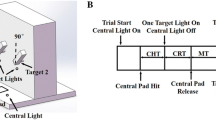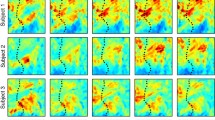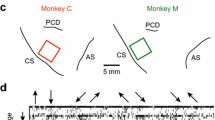Summary
In a previous study in the cat, we have reported that motor cortex neurons discharging before the initiation of an aimed forearm response (lead cells) are better timed to movement of a display (stimulus) than to the response. The present study was done to distinguish the coding of stimulus and response features in the discharge patterns of such early activity in motor cortex. Single neurons were recorded in the arm area of motor cortex in three cats performing the same pair of responses (forearm flexion and extension) but to display movements in either of the two directions by changing display polarity. The modulation of lead cell activity was contingent on the occurrence of the learned motor response and timed to the stimulus in all conditions. The majority of lead cells (88%, n = 50) fell into one of two distinct classes. In one class of neurons, force-direction (56%, n = 32), activity was contingent on a single direction of forelimb response (flexion or extension) and was thus independent of the direction of the display stimulus. The only muscles whose patterns matched the activity of this class of response-related neurons were forelimb flexors and extensors. In these neurons, the onset of modulation was timed to one or the other of the two stimuli according to the stimulus direction which elicited the appropriate response. Thus, the display-related input to these neurons varied according to the response required. In the second class of neurons, stimulus-direction (32%, n = 18), modulation was associated with a specific stimulus direction rather than the response direction. The pattern of activity of these neurons was similar to the pattern of EMG signals of shoulder and neck muscles during the different task conditions. The contraction of proximal and axial muscles corresponded to a second response elicited by the stimulus, namely attempts at head rotation towards the moving display and was independent of the conditioned forelimb response in both time of onset and direction. To test the possibility that stimulus-direction neurons participated in the control of head rotation we trained two of the animals to also produce isometric changes in neck torque in the direction of the moving display without making the forelimb response. The activity of stimulus-direction neurons was similarly modulated during performance of the neck task. By contrast, force-direction neurons examined during the neck task were either unmodulated or discharged after the neck response. These data suggest that force-direction neurons participate in response initiation and that their activity is triggered by stimuli specific for the task. The reorganization of the inputs to motor cortex is likely to result from gating mechanisms associated with behavioral set. Such neural gates could provide for the efficient transfer of any member of an array of behaviorally relevant stimuli to restricted sectors of the somatotopically organized motor areas.
Similar content being viewed by others
References
Amalric M, Conde H, Dormont JF, Farin D, Schmied A (1984) Cat red nucleus changes of activity during the motor initiation in a reaction time task. Exp Brain Res (in press)
Armand J, Kuypers HGJM (1980) Cells of origin of crossed and uncrossed corticospinal fibers in the cat. Exp Brain Res 40: 23–34
Asanuma H, Babb RS, Mori A, Waters RS (1981) Input-output relationships in cat's motor cortex after pyramidal section. J Neurophysiol 46: 694–703
Berkely KJ (1983) Spatial relationships between the terminations of somatic sensory motor pathways in the rostral brainstem of cats and monkeys. II. Cerebellar projections compared with those of the descending somatic sensory pathways in lateral diencephalon. J Comp Neurol 220: 229–251
Brodal P (1968) The corticopontine projection in the cat. I. Demonstration of a somatotopically organized projection from the second somatosensory cortex. Arch Ital Biol 106: 310–332
Bushnell MC, Goldberg ME, Robinson DL (1981) Behavioral enhancement of visual responses in monkey cerebral cortex. I. Modulation in posterior parietal cortex related to selective visual attention. J Neurophysiol 46: 755–772
Evarts EV (1974) Precentral and postcentral cortical activity in association with visually triggered movement. J Neurophysiol 37: 373–381
Evarts EV (1966) Pyramidal tract activity associated with a conditioned hand movement in the monkey. J Neurophysiol 29: 1011–1027
Ghez C, Martin J (1982) The control of rapid limb movement in the cat. III. Agonist-antagonist coupling. Exp Brain Res 45: 115–125
Ghez C, Vicario D (1978a) The control of rapid limb movement in the cat. I. Response latency. Exp Brain Res 33: 173–190
Ghez C, Vicario D (1978b) Discharge of red nucleus neurons during voluntary muscle contraction. J Physiol (Paris) 74: 283–285
Ghez C, Vicario D, Martin J, Yumiya H (1983) Sensory motor processing of targeted movements in motor cortex. In: Desmedt JE (eds) Motor control in health and disease. Raven Press, New York, pp 61–92
Godschalk M, Lemon RN, Kuypers HGJM (1983) Afferent and efferent connections of the postarcuate regions of the monkey cerebral cortex. Soc Neurosci Abstr 9: 490
Hassler R, Muhs-Clement K (1964) Architektonischer Aufbau des sensorimotorischen und parietalen Cortex der Katze. J Hirnforsch 6: 377–422
Hendry SHC, Jones EG, Graham J (1979) Thalamic relay nuclei for cerebellar and certain related fiber systems in the cat. J Comp Neurol 185: 679–714
Jones EG, Coulter JD, Hendry SHC (1978) Intracortical connectivity of architectonic fields in the somatic sensory, motor, and parietal cortex of monkeys. J Comp Neurol 181: 291–348
Kuypers HGJM (1973) The anatomical organization of the descending pathways and their contributions to motor control especially in primates. In: Desmedt JE (eds) New developments in electrophysiology and clinical neurophysiology, Vol 3. Karger, Basel, pp 38–68
Lamarre Y, Spidalieri G, Bushy L, Lund JP (1980) Programming of initiation and execution of ballistic arm movements in the monkey. Prog Brain Res 54: 157–169
Lundberg A (1979) Integration in a propriospinal motor center controlling the forelimb in the cat. In: Asanuma H, Wilson VJ (eds) Integration in the nervous system. Igaku-Shoin, Tokyo, pp 47–64
Martin J, Yumiya H, Ghez C (1981) Coding of target and response variables in cat motor cortex. Soc Neurosci Abst 7: 562
Matsumura M, Kubota K (1979) Cortical projection of hand-arm motor area from post-arcuate area in macaque monkey: A historical study of retrograde transport of horseradish peroxidase. Neurosci Lett 11: 241–246
Mizuno N, Mochizuki K, Akimoto C, Matsushima R, Sasaki K (1973) Projections from the parietal cortex to the brain stem nuclei in the cat, with special reference to the parietal cerebrocerebellar systems. J Comp Neurol 147: 511–522
Muakassa KE, Strick PL (1979) Frontal lobe inputs to primate motor cortex: Evidence for four somatotopically organized ‘premotor’ areas. Brain Res 117: 176–182
Pandya DN, Kuypers HGJM (1969) Corticocortical connections in the rhesus monkey. Brain Res 13: 13–36
Robinson DL, Goldberg ME, Stanton GB (1978) Parietal association cortex in the primate: Sensory mechanisms and behavioral modulations. J Neurophysiol 41: 910–932
Sasaki K, Matsuda Y, Mizuno N (1973) Distribution of cerebellar-induced responses in the cerebral cortex. Exp Neurol 39: 342–354
Schmied A, Benita M, Conde H, Dormont JF (1979) Activity of ventrolateral thalamic neurons in relation to a simple reaction time task in the cat. Exp Brain Res 36: 285–300
Strick PL, Kim CC (1978) Input to primate motor cortex from posterior parietal cortex (area 5). I. Demonstration by retrograde transport. Brain Res 157: 325–330
Tanji J, Kurata K (1982) Comparison of movement-related activity in two cortical motor areas of primates. J Neurophysiol 48: 633–653
Vicario DS, Martin JH, Ghez C (1983) Specialized subregions in the cat motor cortex: A single unit analysis in the behaving animal. Exp Brain Res 51: 351–367
Waters RS, Favovov D, Asanuma H (1982) Physiological properties and pattern of projection of cortico-cortical connections from the anterior bank of the ansate sulcus to the motor cortex, area 48, in the cat. Exp Brain Res 46: 403–412
Webster KE (1965) The cortico-striate projections in the cat. J Anat 95: 532–544
Weinrich M, Wise SP (1982) The pre-motor cortex of the monkey. J Neurosci 2: 1329–1345
Wilson VJ, Peterson BW (1981) Vestibulospinal and reticulospinal systems. In: Brooks VB (eds) Handbook of physiology, Sect I: The nervous system, Vol II. Motor control. American Physiological Society, Bethesda, pp 667–702
Yumiya H, Ghez C (1983) Specialized subregions in cat motor cortex: Anatomical demonstration of differential projections to rostral and caudal sectors. Exp Brain Res 53: 259–276
Author information
Authors and Affiliations
Rights and permissions
About this article
Cite this article
Martin, J.H., Ghez, C. Task-related coding of stimulus and response in cat motor cortex. Exp Brain Res 57, 427–442 (1985). https://doi.org/10.1007/BF00237829
Received:
Accepted:
Issue Date:
DOI: https://doi.org/10.1007/BF00237829




